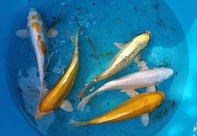In South Africa, ornamental fish farming is considered the ‘Cinderella’ or poor cousin of food fish aquaculture and industry experts predict this will not change soon.

Many small-scale ornamental farms and one large scale farm have come and gone over the years but no real commercial-scale ornamental fish producers exist in South Africa.
There are many reasons for this, but the most important reasons are cost and quality. These ornamental fish species are kept for their beauty and not for eating and are essentially a luxury item. Where there is little money for other than the bare necessities of life, ornamental fish are not on the shopping list.
The Market for Ornamental Fish
Middle-class income earners and businesses that have display fish tanks are the main markets for most ornamental fish. In wealthy and well-organised societies, specialisation in ornamental fish-keeping gives rise to hobby fish-keepers who often invest large amounts of money on fish tanks and equipment, even to the extent of whole basements completely filled with fish tanks.
Germany and Holland are examples of countries where the ornamental fish as a hobby is developed enough to support imports, distribution and services at both the livestock and equipment level. These countries have ornamental fish societies and user groups that meet, produce regular publications and even organise visits to the countries of origin of the fish they keep.
Lake Malawi and the Amazon River are popular destinations. South Africa is far from this. The ornamental fish industry in South Africa reached a peak in the late 1990s and has been in decline since then.
This is partly due to the decline of the South African economy and partly due to the rise of the internet and ‘computer age’ where the hobby of fish keeping has been replaced by an interest in social media and electronic devices, especially by the youth.
Production of Ornamental Fish
Breeding and rearing of ornamental fish are not easy as it is a sector where the need for high-quality fish is extremely important. Ornamental fish are mass-produced in the Far East, with countries like Singapore, Taiwan, Japan and also Israel, amongst the leaders.
South Africa imports about 95% of its live ornamental fish from this region. There are many role players - Singapore has over 400 fish farms - so competition is fierce and the supply needs to be efficient and highly organised.
Most farms distribute through well-organised cooperatives that sell in bulk from a multitude of small-scale suppliers.
Many of these small-scale suppliers are family businesses that produce only one or two fish species. Fish are distributed by air to markets all over the world. The quality and range of ornamental fish species available are impressive.
New ‘species’, strains and colour forms are continually produced, which keeps the worldwide market stimulated. Certain species are considered fads and fashions as the hobby fish-keeper market continually demands ‘something new’.
By Nick James